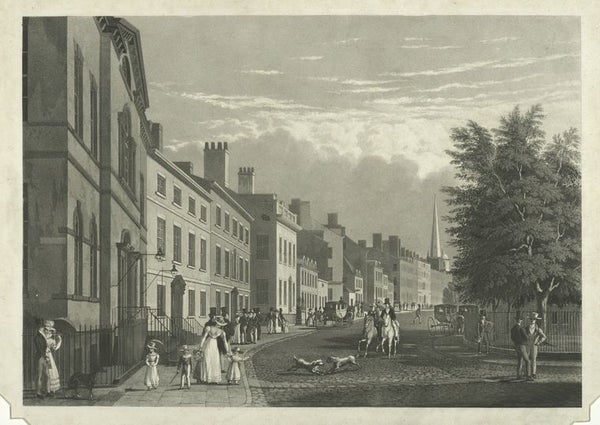This article was published in Scientific American’s former blog network and reflects the views of the author, not necessarily those of Scientific American
Yes, there was actual bowling at Bowling Green. As New York City's oldest park, one of the activities it hosted was lawn bowling. In 1682 the British declared the space to be public property and it served as an informal communal space. The City leased the space to three landowners in 1733 for the cost of one peppercorn per year. John Chambers, Peter Bayard and Peter Jay were responsible for "beautifying" the space--they planted trees, erected a fence and established a bowling green. The game itself is comprised of rolling biased balls so they stop as close as possible to a smaller ball. It takes a toll on the lawn, as you can imagine, so it would have required heavy maintenance, which possibly was accomplished by allowing sheep to graze in the space (as this was a common tactic during this time).
Bowling Green has come under a great deal of scrutiny since it was linked by the White House (through sheer circumstance) to an alleged terrorist massacre. That account is based on a misappropriation of facts. Additionally, the Bowling Green referenced there is in Kentucky, but New York City's historical site of the same name played an important role in the development of the City, and it has its own tragedy tied to it.
We know that there was indeed a slaughter of the Lenape Indians at the hands of Dutch soldiers in 1643 at two metropolitan locations, one of which is the site of Bowling Green. Tensions between the settlers and the Lenape had been fostered by Governor-Director Willem Kieft, who tried to levy a tax against the Lenape to raise revenue and would not deal European firearms to them, which put them at a disadvantage when their enemies were able to obtain guns from Dutch sailors.
On supporting science journalism
If you're enjoying this article, consider supporting our award-winning journalism by subscribing. By purchasing a subscription you are helping to ensure the future of impactful stories about the discoveries and ideas shaping our world today.
On February 25, 1643 two groups of Lenape sought refuge from the Mahicans. And Kieft personally led a raid and killed 80 Lenape in what is now Pavonia, New Jersey. His soldiers killed another 30 at Bowling Green. The killings were savage and are graphically described in the annals of history. Apparently, the Dutch local citizen advisory board had been specifically opposed to this raid. The certainly had to be unhappy when the result of this tactical maneuver resulted in a two year war--Kieft's War--with neighboring Algonquian tribes that nearly undid New Amsterdam. Fortunately, Kieft was fired by the Dutch West India company, and New Amsterdam flourished--and Bowling Green went on to have a significant role in the history of the growing city.
Here are three additional facts about Bowling Green that attest to its importance in the development and growth of New York City:
In 1677 the City's first public well was dug on the site. Previously, settlers got water from shallow, privately-owned wells, such as the well at present-day Goldman Sachs, which was the site of the Philipse Manor in the 18th-century. The public well was a sign that the population was growing and signalled the start of a water supply system.
George Washington lived here until the capital was moved to Philadelphia. The Bowling Green area was possibly an early example of gentrification. As one of the oldest settled areas of the young colony, the residences that were eventually established around the park included the wealthier citizens of New Amsterdam, earning it the derogatory nickname of Nobs Row.
It was the site of an early incident of revolutionary rebellion. A loyalist statue of King George III was erected there in 1770 only to be pulled down by revolutionary New Yorkers following the reading of the Declaration of Independence. The statue was dragged through the streets and dismantled. A portion of it was melted down for bullets, but pieces of it have surfaced through the years. The New York Historical Society holds many of the pieces--except for the head, which was secreted back to England by sympathizers and remains unaccounted for today.
These facts are only the tip of the iceberg. The Dutch used Bowling Green as a parade ground, a meeting place, and a cattle market. Prior to that it was a council spot for surrounding Native American tribes. Bowling Green has enough history to stand on its own. Hopefully, the alternative facts being circulated isn't included in its legacy.
Have something to say? Comments have been disabled on Anthropology in Practice, but you can always join the community on Facebook.
--
You might also like:
The Story of Grand Central Station and the Taming of the Crowd
Smells from the Past: The Fulton Fish Market
When the Lights Go Down in the City
--
Image Credit:
The Miriam and Ira D. Wallach Division of Art, Prints and Photographs: Print Collection, The New York Public Library. "Broad Way from the Bowling Green" The New York Public Library Digital Collections. 1834. http://digitalcollections.nypl.org/items/510d47d9-7b93-a3d9-e040-e00a18064a99
